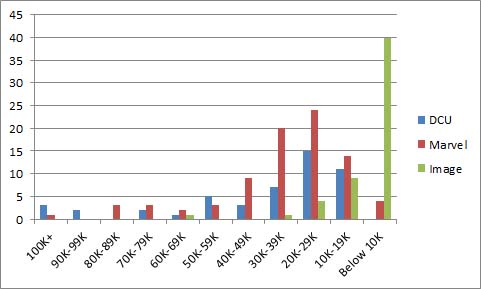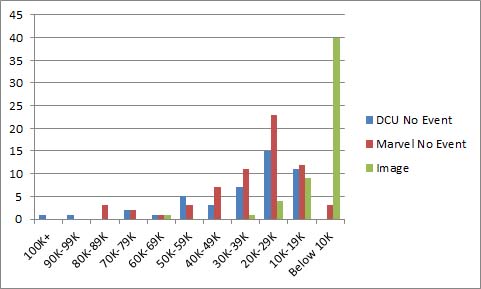Wrapping up our sales distribution charts, the comparison chart of DC, Marvel and Image for September 2018. So we can see where the biggest sales sit on the Direct Market Landscape. (Methodology explained at the bottom of the page.)
When we include the Events and #1s, that’s not the worst-looking chart we’ve ever seen. Every sales band has something in it. Far too many titles below 30K, however, but that’s the new norm. The under 10K category is actually cleaned up quite a bit. Of course that’s with Events and Events aren’t going to come out like clockwork. Doomsday Clock is on a cough staggered release schedule and a cloud of uncertainty hangs over Batman: Damned, despite a hot launch. Return of Wolverine is not selling any 260K copies of #2. Nope. Not gonna happen. So let’s pull back away from the Events.
And now things aren’t quite so pretty. On the top list, we see Batman split between 100K+ and the mid-90Ks. Which side of the 90K line will it settle on? To be determined. (Avengers is in a similar situation hitting on either side of the 60K line.)
It absolutely is encouraging to see Fantastic Four and Amazing Spider-Man selling in the 80Ks. We need to see where FF is in a couple months, but Spidey is demonstrating some staying power at those levels. Venom and Justice League are hanging around in the 70Ks. These sales bands were an empty valley of death on the chart not so long ago. Oh sure, I have speculator concerns about the Marvel titles on top, but if the books are selling through, so be it.
The more interesting dip between the two charts is in the 30K-39K sales band. Marvel had a couple minor Events: a Venom weekly and the Spider-Geddon lead in placing there. Titles selling over 30K an issue really ought to be profitable for most shops unless they’re really over ordering. 30K copies over 2500 shops should give an average of around 12 copies/shop. One or two copies can sit on the shelf without throwing the economics of the order into disarray. A lot of publishers, but particularly Marvel, seem to be gravitating towards these weekly mini-Events. For instance, in October DC is doing a Wonder Woman / Justice League Dark Event and later Uncanny X-Men will return as weekly. Since weeklies don’t really work so well for retailers trying to adjust their orders, this is something to keep an eye on. So far it’s been working out for most parties involved. Thing is, when a weekly doesn’t sell through or the orders come in lower, we’ll have to see how all parties involved tolerate it. It certainly makes ordering more stressful for retailers.
What we don’t have on this chart is Stranger Things #1, which sold ~60K and another ~76K in retailer variants directly through Dark Horse. Yes, some of those variants went to GameStop and are outside the DM, but that potentially gives us another top list book and cash cow. We’ll have to see how many of those first issues sold through and what level it stabilizes at.
I’m not ready to say the market is rebounding, but there’s a bit more to the top list – not just the Events and launches – and the low end is cleaning up a bit. Things could be a lot better, but we’ve seen them worse in the last year.
Standard disclaimers: The numbers are based on the Diamond sales charts as estimated by the very reliable John Jackson Miller. These charts are pretty accurate for U.S. Direct Market sales with the following caveats: 1) you can add ~10% for UK sales, which are not reflected in these charts; 2) everyone’s best guess is you can add ~10% for digital sales – while some titles do sell significantly better in digital (cough Ms. Marvel cough), that’s the average rule of thumb; 3) it’s not going to include reorders from subsequent months, although reorders will show up in subsequent months if they’re high enough. So if you’re a monster seller in Southampton and it took the US audience 3 weeks to reorder, it’s probably not going to be reflected here.
What’s a sales band? It’s another way to have a higher level view of the market. The general idea is to divide the market into bands of 10K copies sold and see how many issues are in each band. How many issues sold between 90-99K copies, 80-89K copies, etc. etc. In very broad terms, the market is healthier when there are several titles selling in the 70K-100K+ range because titles that move a lot of copies give the retailers some margin of error on their ordering. When you see titles selling in the 20-29K band and especially below, there’s a pretty good chance a lot of retailers aren’t ordering those titles for the shelf (pull box/pre-order only) or minimal shelf copies at best.
Want to learn more about how comics publishing and digital comics work? Try Todd’s book, Economics of Digital Comics











Well, Todd, from the recent months trends and the way comics publishers work, I’d say look for the comics line to have a majority amount of event comics in the future. Maybe that’s the only way the business model will work from now on.
Not to be cynical (gosh, I love all forms of comic book storytelling), but the larger pop culture appreciation of superhero stories is about big events. Disney has found success in a shared Marvel movie universe with all of the latest movies being “crossovers”, “team-ups”, “tie-ins”, and full on universe wide “events.” Hmmm, sounds like comic book style events to me. And the movie going public wants the same from DC, from Harry Potter, from Hunger Games, and all their favorite franchises. It’s only natural that comic publishers follow the same cultural leanings – big, high budget, flashy, epic events. So for the foreseeable future, comic “events” will drive discussion and sales promotions from the Big Two publishers.
I can’t speak to Hunger Games but Harry Potter was always intended to be one interconnected series of films as that was what the novels were. Like the Expanse series first on Sci-fi and now on Amazon, such film series are popular. And audiences are fond of following a group of characters they’ve come to know. I started watching the animated Guardians of The Galaxy in part because I know the characters and the setting. It tuned out to be quite good.
Thank you, Cat. That’s what I was struggling to summarize. People today like to see their favorite groups of characters tackling challenge together, not lone hero stories as much. Shoot, every TV series has a tech person, the computer guru back at the home base, the goof, the responsible one, the rebel, etc. So why not the Avengers, the Justice League, the Defenders, the Spider-Verse…?
I think it might be more accurate to say that publishers trained the public to buy events without thinking about what it would do to the rest of the line if only events mattered… but it’s a problem of their own making. That’s what happens when you chase short term profits.
Todd, you’re probably right. The publishers have definitely sold us events at the expense of solid character stories. Now they’re in the position where every event has to be a home run or else the publishing line falls apart for months.
And directors have trouble setting up a movie at the major studios unless it can spawn a franchise. Which leads to the sameness of so many movies. Not everything has to be part of a “shared universe.”
Comments are closed.